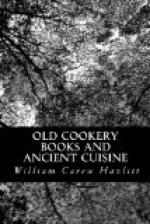“Explicit de Coquina
Quae est optima Medicina.”
The “Form of Cury” will amply remunerate a study. It presents the earliest mention, so far as I can discern, of olive oil, cloves, mace, and gourds. In the receipts for making Aigredouce and Bardolf, sugar, that indispensable feature in the cuisine, makes its appearance; but it does so, I should add, in such a way as to lead to the belief that the use of sugar was at this time becoming more general. The difficulty, at first, seems to have been in refining it. We encounter here, too, onions under the name borrowed from the French instead of the Anglo-Saxon form “ynne leac”; and the prescriptions for making messes of almonds, pork, peas, and beans are numerous. There is “Saracen sauce,” moreover, possibly as old as the Crusades, and pig with sage stuffing (from which it was but one step to duck). More than one species of “galantine” was already known; and I observe the distinction, in one of the smaller collections printed by Warner, between the tartlet formed of meat and the tartlet de fritures, of which the latter approaches more nearly our notion. The imperfect comprehension of harmonies, which is illustrated by the prehistoric bag-pudding of King Arthur, still continued in the unnatural union of flesh with sweets. It is now confined to the cottage, whence Arthur may have himself introduced it at Court and to the Knights of the Round Table.
In this authority, several of the dishes were to be cooked in white grease, which Warner interprets into lard; others demanded olive oil; but there is no allusion to butter. Among the receipts are some for dishes “in gravy”; rabbits and chickens were to be treated similarly; and the gravy appears to have consisted merely of the broth in which they were boiled, and which was flavoured with pounded almonds, powdered ginger, and sugar.
The “Liber Cure Cocorum,” which is apparently extant only in a fifteenth century MS., is a metrical treatise, instructing its readers how to prepare certain dishes, condiments and accessories; and presents, for the most part, a repetition of what has already occurred in earlier and more comprehensive undertakings. It is a curious aid to our knowledge of the manner in which the table of the well-to-do Englishman was furnished in the time of Henry VI., and it is so far special, that it deals with the subject more from a middle-class point of view than the “Regulations for the Royal Household,” and other similar compilations, which I have to bring under notice. The names, as usual, are often misleading, as in blanc manger, which is very different from our blanc-mange; and the receipt for “goose in a hog pot” leaves one in doubt as to its adaptability to the modern palate. The poetical ambition of the author has proved a source of embarrassment here and there; and in the receipt “for a service on a fish-day” the practitioner is prayed within four lines to cover his white herring for God’s sake, and lay mustard over his red for God’s love, because sake and love rhyme with take and above.




